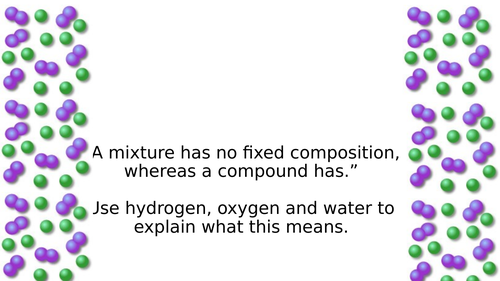AQA 1-9 Atomic Structure Topic Bundle
A comprehensive set of lessons to start 9-1 GCSE chemistry / trilogy course. There are 9 lessons in total, which includes a revision lesson.
Everything you need in one powerpoint per lesson, including printable “worksheet” slides, clear notes on delivery (including teaching tips) and answers that reveal one at a time for easy questioning and self-assessment.
Yellow challenge boxes are included to stretch the more able students in your class and provide opportunities for differentiation.
Many of the resources include entertaining games, past paper questions, choices of tasks and more than enough content to fill a lesson.
Lesson overview:
Atoms, elements and compounds: Students explore identifying elemental symbols, naming compounds and the start of atomic structure.
Chemical equations: what a word equation tells you; converting word equations to symbol equations; balancing equations and state symbols.
Separating mixtures - filtration and crystalisation: Students review key words essential to understanding these techniques, then complete a practical to separate sand and salt using them. Finally, students test their knowledge with a past paper question. This helps students to gain confidence in the course, as they are able to answer a GCSE exam question only a few lessons in.
Separating mixtures - distillation: introduces distillation and builds on the previous learning of filtration and crystalisation. Students explore how to use distillation to separate mixtures and the differences between simple and fractional distillation. There is an optional practical activity included in this lesson.
History of the atom: Students explore everything they need to know on this topic and make a timeline using cut-and-stick information, highlighting the scientist names, experiments leading to the model and descriptions of the models themselves.
Structure of the atom: This lesson introduces how students can work out the number of each sub-atomic particle, as well as drawing electronic structures and linking these to the periodic table.
Isotopes: Students explore the definition of an isotope, Ar calculations and the differences between the properties of isotopes.
A “catchphrase”-style game is also included, allowing students to compete to be the first to answer the exam question that is revealed.
Forming ions: introduces students to the idea of forming ions, with plenty of opportunity for practice.
Revision lesson: reviews atomic structure, isotopes and ions with fun activities, including retrieval grids, reward ladders and a scrabble-based plenary.

